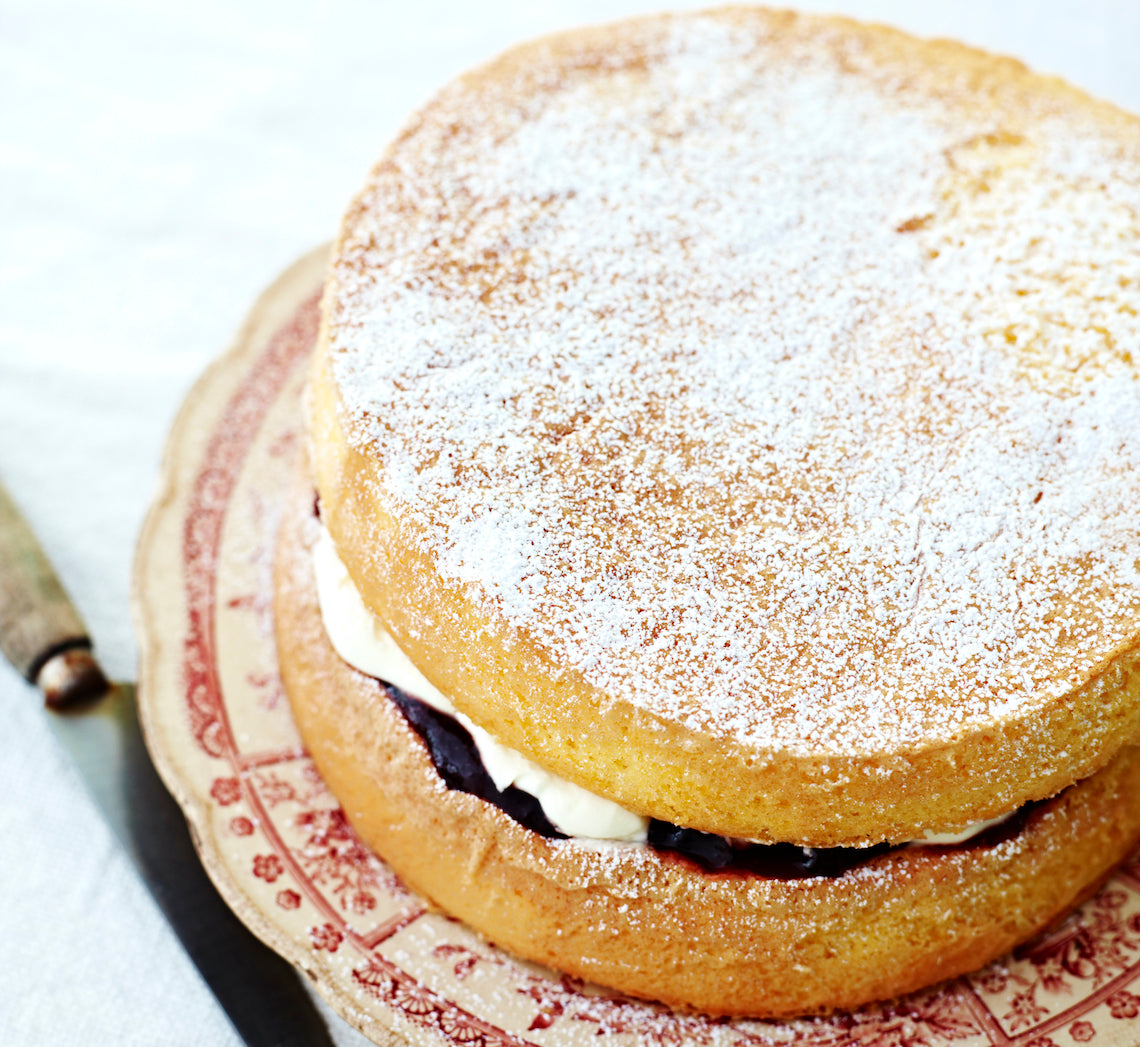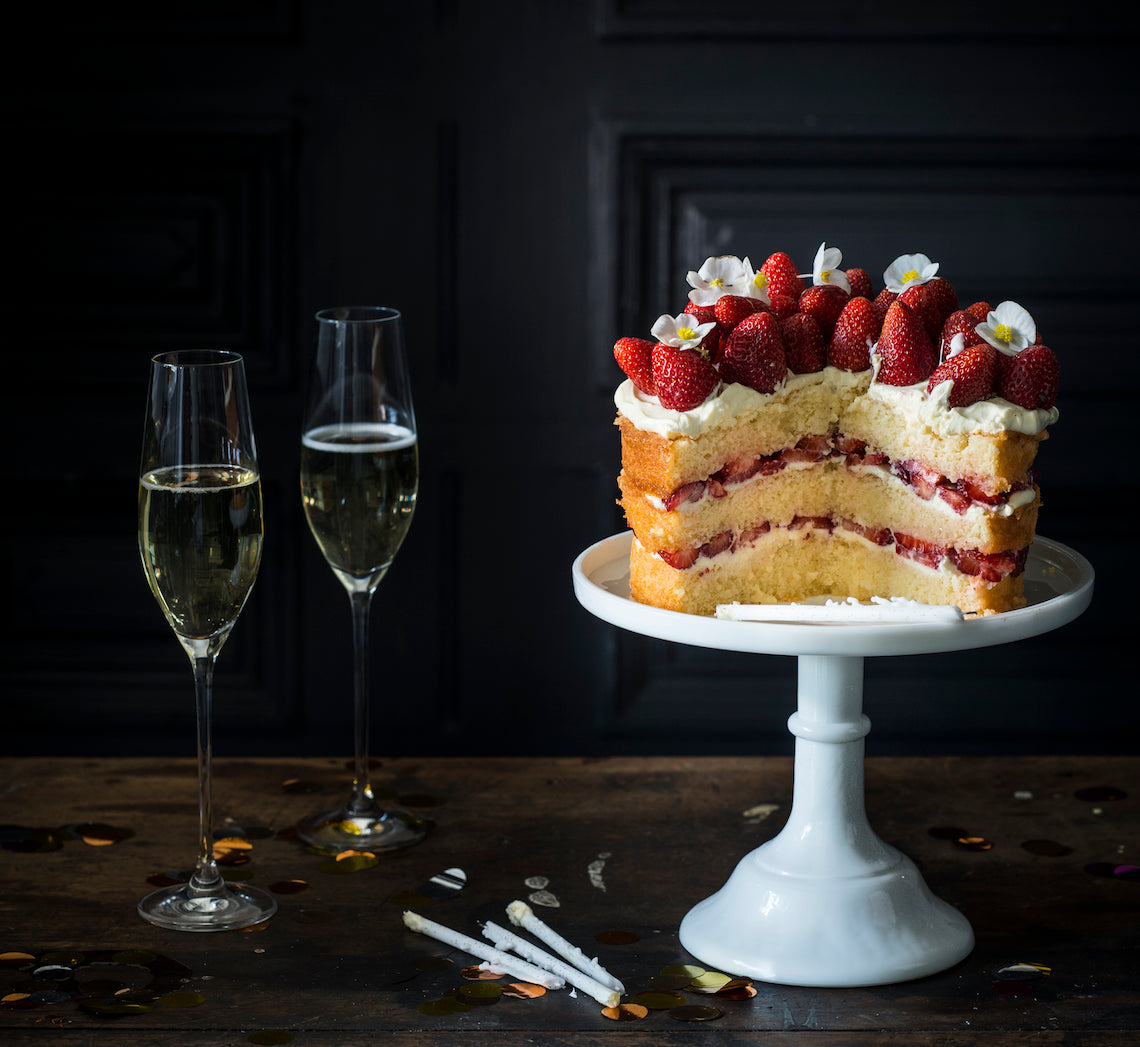- home
- BAKERECIPES
BakeRecipes
Bringing real baking into your home with deliciously simple recipes.

Prep 25minBake 18-20minMakes 8 serves
There are two main tricks when making a sponge: don’t over whisk the mixture once you have added the flour, and keep a close eye on your sponge in the oven – it will be dry if over baked.
Ingredients
15g butter, melted and combined with 1½ teaspoons plain flour
4 x 59g eggs, at room temperature
165g (¾ cup) caster sugar
60ml (¼ cup) milk
30g butter, room temperature, diced
110g (¾ cup) self-raising flour, plus extra to dust
30g (¼ cup) cornflour
125ml (½ cup) pure cream, chilled
225g (⅔ cup) strawberry or raspberry jam
Icing sugar, to dust
Method
- To make the Sponge Layers, place the oven rack in the oven so that the cake tins will sit in the middle of the oven and then preheat it to 180°C (160°C fan-forced). Brush two shallow 20cm/8in round cake tins with the melted butter mixture to grease and line the base of each with a round of non-stick baking paper. Brush the bases again with the melted butter mixture.
- Use an electric mixer with a whisk attachment on medium-high speed to whisk the eggs in a large bowl until frothy. Add the sugar a spoonful at a time, whisking well after each addition, until the mixture is very thick and pale (this will take about 8 minutes). Lift the whisk out of the mixture and draw a figure eight, if the trail stays on the surface long enough to finish drawing, then the mixture is ready. If not, continue to whisk for a further minute.
- Meanwhile, heat milk and butter in a small saucepan over medium heat until almost simmering. Remove from heat and pour down the side of the mixing bowl. Quickly sift the flour and cornflour together over the egg mixture and then immediately whisk again with the electric mixer on low speed briefly until the flour mixture is just incorporated (be careful not to overmix). Scrape the base of the bowl and then whisk briefly again, if necessary.
- Divide the mixture evenly between the cake tins (see Baker’s Tips) and gently tap the tins on the bench top three times to settle the mixture. Bake in preheated oven for 18-20 minutes or until the cakes are a pale golden colour, spring back when lightly touched in the centre and start pulling away from the sides of the tins. Remove from the oven and immediately use a small palette knife to loosen the top of the sponges from the tins and turn onto a wire rack (see Baker’s Tips), top side up, to cool completely.
- When ready to fill, use a hand-held electric mixer with a whisk attachment or a balloon whisk to whisk the cream until soft-firm peaks form. Spread one cake with the jam and then the whipped cream. Top with the remaining cake and dust with icing sugar.
Baker's Tips
- To divide the mixture evenly between the tins, weigh the tins with the mixture in them to make sure they are the same weight.
- When removing the cakes from the tins, turn them onto a wire rack covered with a tea towel before inverting onto another rack. The tea towel will prevent the rack marking the tops of the cakes.
- Sponge cakes are best eaten the day they are baked. Sandwich them together just before serving.
Photography by Julie Renouf.

Prep 40min (+ 30min cooling time)Bake 30minMakes 8-10 serves
If there ever was a cake that epitomised the flavours of England this would be it! The combination of elderflower, strawberries and gin not only make this chic sponge cake uniquely special but also incredibly lust-worthy.
Ingredients
250g ripe strawberries, hulled and sliced
500g small ripe strawberries, to serve
icing sugar, to dust
fresh elderflowers (optional), to decorate (see Baker’s Tips)
Mascapone cream
185ml pure (thin/pouring) cream
250g mascarpone
2 tablespoons undiluted elderflower cordial /drink concentrate, or to taste
Sponge layers
Melted butter, to grease
4 fresh eggs, at room temperature
1½ teaspoons natural vanilla essence or extract
165g (¾ cup) caster sugar
60ml (¼ cup) milk
30g butter, diced
110g (¾ cup) self-raising flour
30g (¼ cup) cornflour
Elderflower and gin syrup
165ml (¾ cup) undiluted elderflower cordial /drink concentrate
60ml (¼ cup) strained fresh lemon juice
80ml (⅓ cup) gin
Method
- To make the sponge layers, place the oven rack in the oven so that the cake tins will sit in the middle of the oven and then preheat it to 180°C (160°C fan-forced). Brush three 18cm non-stick springform tins with a melted butter to grease.
- Use an electric mixer with a whisk attachment on medium-high speed to whisk the eggs and vanilla in a large bowl until frothy. Add the sugar a spoonful at a time, whisking well between each addition, until the mixture is very thick and pale and the sugar has dissolved (this will take about 8 minutes). Lift the whisk out of the mixture and slowly draw a figure eight, if the trail stays on the surface long enough for you to finish drawing then the mixture is ready. If not, continue to whisk for a further minute and then test again.
- Meanwhile, heat the milk and butter in a small saucepan over medium heat until the butter melts and mixture is almost simmering. Remove from the heat. Pour the hot milk mixture down the side of the bowl then quickly sift the flour and cornflour together over the whole surface of the egg mixture. Immediately whisk briefly again with the electric mixer on low speed, until the flour mixture is just incorporated (make sure there is no flour caught at the bottom of the bowl and be careful not to overmix).
- Divide the mixture evenly between the cake tins and gently tap the tins on the bench top three times to settle the mixture. Bake in preheated oven for 15 minutes or until the cakes are a pale golden colour, spring back when lightly touched in the centre and start pulling away from the sides of the tins. Remove from the oven and stand for 1 minute before turning onto a wire rack over a tray, top side up.
- Meanwhile, to make the Elderflower and gin syrup combine the elderflower cordial /drink concentrate and lemon in a small saucepan and heat over medium heat until hot but not simmering. Remove from heat and stir through the gin.
- Use a skewer to prick the warm sponge layers all over. Gradually pour the hot syrup over the warm cake, allowing it to soak in. Set aside to cool completely (this will take about 30 minutes).
- When ready to assemble, use a hand-held electric mixer with a whisk attachment or a balloon whisk to whisk the cream in a medium mixing bowl on medium-low speed until soft peaks form. Add the mascarpone and elderflower cordial /drink concentrate and whisk on low speed briefly until just combined and thickened to a medium whipped cream consistency. Place one layer of the sponge on a serving plate or cake stand and dollop a third of the mascarpone cream evenly over the top. Use the back of a metal spoon to gently spread the cream from the centre of the cake towards the outside to cover, leaving about a 1cm border around the edge. Then top with half the sliced strawberries. Top with another sponge layer, half of the remaining cream and remaining sliced strawberries. Top with the remaining sponge layer and spread with the remaining cream. Decorate with the whole strawberries.
Baker's Tips
- I used white Waxed Leaf Bergonias to decorate this cake.
- This cake can be assembled about 2 hours before serving. Stand at room temperature in a cool spot.
- The sponge cake layers will keep in airtight container, divided by baking paper, at room temperature for up to 2 days.
How to cut a multi-layer sponge cake
Cakes with multiple layers, especially those made up of various textures such as sponge cakes, can be tricky to cut the traditional way – cutting downwards often squashes the cake, causing the softer filling to ooze unevenly out the side and leaving you with an unsightly mess.
The trick to avoid this, is to use a sharp serrated knife that has a pointed end and is at least the length of the height of the cake.
Insert it into the centre of the cake vertically and use a gentle, slow sawing action to cut the cake. The layers will miraculously stay intact as each slice is cut and removed from the cake.
This recipe is from Anneka's SBS Food online column Bakeproof: Celebration Cakes. Click here for more Bakeproof columns and recipes.
Photography by Alan Benson.






